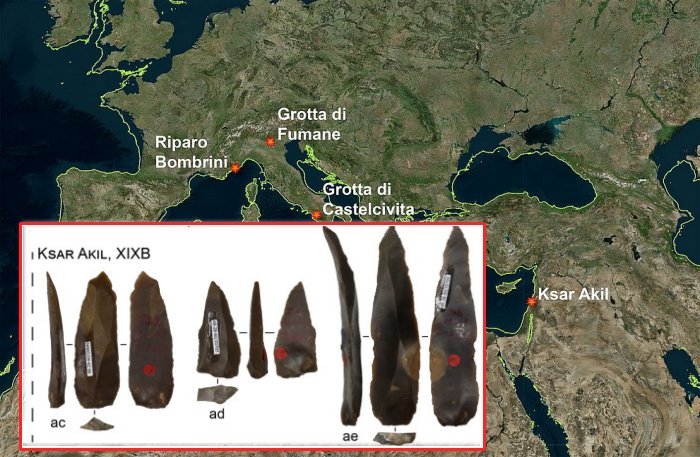Conny Waters – AncientPages.com – Researchers from the universities of Tübingen and Arizona are examining the widely held belief that a significant culture, dating back approximately 42,000 years, was introduced to Europe by people migrating from the Middle East.
Image source:
The team – Dr. Armando Falcucci from the Department of Early Prehistory and Quaternary Ecology in the Department of Geosciences at the University of Tübingen and Professor Steven Kuhn from the School of Anthropology at the University of Arizona in Tucson. – have investigated stone tools from sites in Italy and Lebanon, and their study revealed that modern humans in Europe and the Near East used different methods to make stone tools around 42,000 years ago.
The main goal of this research is to provide new insights into this historical assumption and contribute to our understanding of cultural development during that period.
Their conclusion is that the development of stone-working technology in Europe was primarily driven by local innovations. This advancement cannot be attributed to the transfer of knowledge from Near Eastern migrants, highlighting Europe’s independent technological progress in this area.
The Near East has long been considered a vital biogeographical passageway for the migration of our ancestors, Homo sapiens, as they left Africa. For many years, scholars have pondered the idea that numerous technological advancements reached Europe through the movement of early modern people from this region.
The approximately 42,000-year-old Protoaurignacien culture, which thrived in the regions of southern Europe, is often thought to be a western extension of the Near Eastern Ahmarian culture.
This connection provides intriguing insights into the migratory patterns and cultural exchanges of early Homo sapiens groups. The Protoaurignaciens are believed to have played a significant role in spreading new technologies and artistic expressions across Europe.
Researchers examined tools, ornaments, and cave art attributed to these early humans, so they can now piece together a broader understanding of how these two cultures influenced each other and contributed to the evolution of human societies as they spread across different landscapes.
Many scientists have observed cultural similarities between Ahmarian and Protoaurignacian stone tools, but no systematic comparison has been conducted. Armando Falcucci and Steven Kuhn are addressing this gap.
According to Kuhn, while the stone tools from various regions appeared similar at first glance, there was a need for a deeper understanding of their construction. The research concentrated on the stone inserts used in assembled tools. Falcucci elaborates that they meticulously reconstructed the process by which flint nodules were shaped to create straight blades with sharp edges.
The team studied thousands of Ahmarian stone tools from Ksar Akil, near Beirut, Lebanon.
The worked Protoaurignacien stones for the comparison came from three sites in present-day Italy: the Grotta di Fumane near Verona in the northeast, the Riparo Bombrini near Ventimiglia in the northwest, and the Grotta di Castelcivita near Salerno in the south.
The analysis revealed significant differences between Ahmarian and Protoaurignacien toolmakers. Although both regions saw stone tools becoming smaller, reflecting more complex, assembled tools, they produced small blades differently.
The map of the Mediterranean Sea showing the geographical locations of the sites examined and the reconstructed sea level about 42,000 years ago. Source
Falcucci pointed out that the Ahmarian and Post-Ahmarian techniques in the Near East differ from the Protoaurignacien in Italy. Flake production differences indicate European hunter-gatherers developed their projectile technology independently,
According to Kuhn, the prevailing belief that Stone Age technological advancements in Europe were brought by waves of immigrants from the Near East requires reconsideration. Recent biomolecular and fossil evidence indicates that Homo sapiens started spreading across Eurasia at least 60,000 years ago. During this period, local populations of Neanderthals and Denisovans inhabited the region, and they interbred as noted by Falcucci.
The study indicates that the spread of modern humans across Eurasia was a complex, non-linear process. It highlights the significance of considering cultural exchanges with our extinct relatives, the Neanderthals and Denisovans, which are often underestimated, in reconstructing our history.
Researchers emphasize that archaeological evidence plays a crucial role in this understanding.
Written by Conny Waters – AncientPages.com Staff Writer






Recent Comments